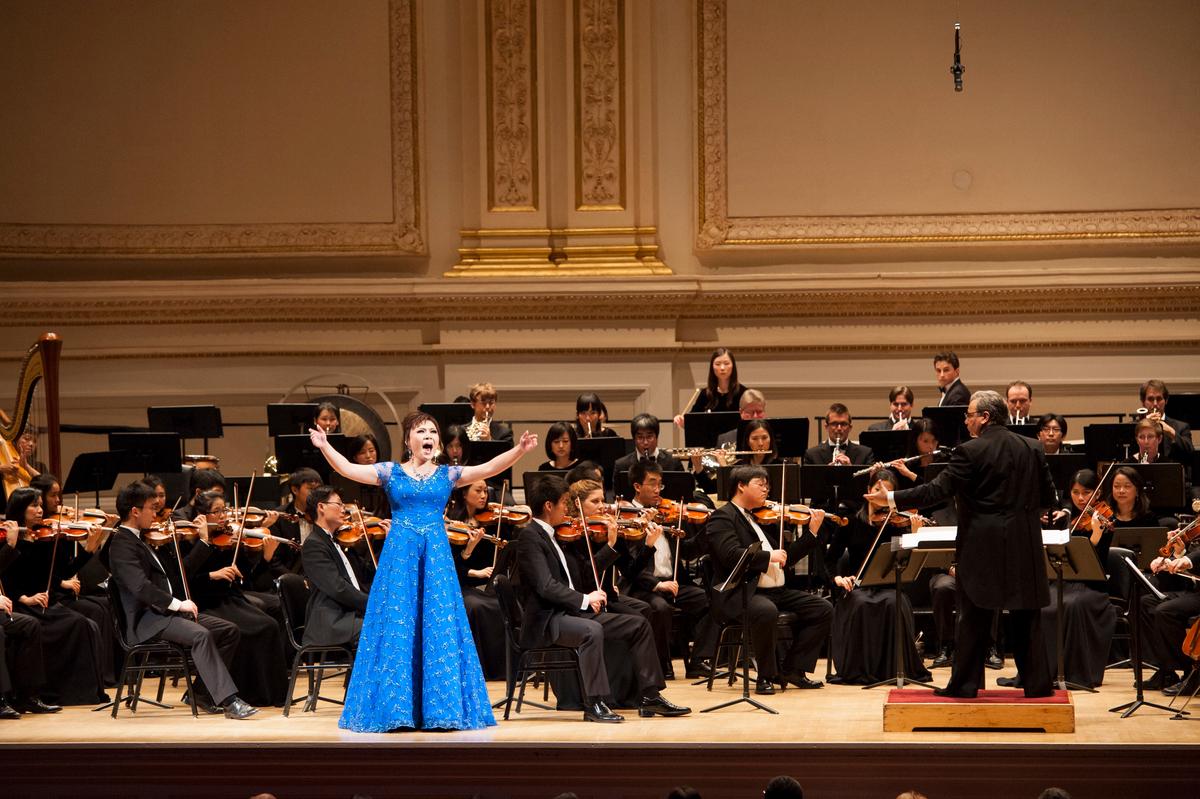NEW YORK—It doesn’t matter if you’re unfamiliar with Chinese music. Whenever you hear an erhu, it will stir the core of your soul, said Keng-Wei Kuo, a conductor for Shen Yun Symphony Orchestra.
The erhu is a two-stringed Chinese violin with a 4,000-year-old history.
“People always find it moving because it is a part of a basic characteristic of humanity to be able to connect with this kind of music,” Kuo said.
Shen Yun Symphony Orchestra is a symphony orchestra that merges Eastern and Western instruments, and it is returning to Carnegie Hall on Oct. 5.
According to Kuo, no background knowledge is needed to revel in the mesmeric character of traditional Chinese instruments.
“It’s one of the instruments that is closest to original music heard by man,” he said. “That’s why there is a natural feeling to it that people connect with, even if they aren’t Chinese or familiar with Chinese music.”
The violin is also an age-old instrument. But with the addition of fine tuners, shoulder rests, and the alteration of sound post locations over the years, most violins sound quite different from the violins that were heard by Mozart.
The erhu is one of the few instruments preserved in their original form for the most part. Besides the erhu, many ancient Chinese instruments have a similar effect when heard—such as the 2,000-year-old pipa that resembles a Western guitar.
An opportunity to hear these instruments live is with Shen Yun Symphony Orchestra, which returns to Carnegie Hall after its debut in 2012. Shen Yun Symphony Orchestra combines the grandeur of a symphonic orchestra with the distinct flavors of Chinese instruments.
But combining Eastern and Western instruments in one orchestra is no easy feat.
The frequencies of the notes played by Chinese instruments vary from those of the West, making it difficult to harmonize Eastern and Western instruments on a large scale. But Shen Yun Symphony Orchestra has been doing that since 2006.
Kuo explains that Shen Yun is able to accomplish this harmonization because its composers understand how to preserve the innate qualities of the instruments from both cultures.
“Western instruments focus on the harmony, while Chinese instruments focus on the distinct flavor of the individual instruments,” Kuo said.
For instance, Chinese percussion instruments can perform solos on their own, while Western percussion instruments’ main goal is to enhance the orchestra.
He noted that composers who have attempted the merger of East and West in the past tried to harmonize the Chinese instruments. They wrote Western flute parts for the Chinese bamboo flute, or dizi, and violin styles for the erhu. Shen Yun Symphony Orchestra composers do exactly the opposite.
But why combine music from two cultures?
There are many great qualities in Western music that Eastern music doesn’t have. A symphonic orchestra has the capacity to produce the richest sounds through harmony.
“This way, it combines the best qualities of both cultures of music,” Kuo said.
About Shen Yun Symphony Orchestra
Shen Yun Symphony Orchestra accompanies the classical Chinese dance company Shen Yun Performing Arts. It was founded by overseas Chinese artists who aim to revive traditional Chinese culture through freedom of speech in the West.
Much of traditional Chinese culture was destroyed during the Chinese Cultural Revolution (1966–1976). Even today, many cultural performances in China still hold Chinese Communist Party elements.
Shen Yun is currently the only performing arts company that is reviving truly authentic Chinese culture.
In addition to performing original Shen Yun compositions at Carnegie’s Perelman Stage on Oct. 5, the orchestra will also perform Western pieces such as Tchaikovsky’s Polonaise from “Eugene Onegin” and Beethoven’s “Egmont” Overture.
The program also includes solos from Shen Yun’s award-winning singers, who perform Chinese texts in bel canto technique.
Bringing Inner Peace to Audiences
What Kuo finds most striking about Shen Yun Symphony Orchestra is that listeners find peace in the meaning behind the music.
For much of China’s 5,000 years, it was influenced by Buddhism and Confucianism, which advocate peace and harmony in society.
“Chinese music is imbued with characteristics from that time period. It is filled with this collective aim for sustaining peace in society,” he said. “Its music is performed for the good of others.”
“I’ve gotten audience feedback that they found they felt an inner peace after listening to our music,” he said. “People find it uplifting.”
“I understand that to be the case because they can use the simplest notes to convey the most profound ideas,” he said. Traditional Chinese music uses only five chromatic notes whereas the Western chromatic scale comprises 12 pitches.
“The music already has a profound message behind it,” he said. “So it doesn’t need extra notes like half steps to create something moving.”
Shen Yun Symphony Orchestra at Carnegie Hall
Perelman Stage, Carnegie Hall
Saturday, Oct. 5, 2 p.m. and 8 p.m.
http://symphony.shenyun.com/
Tickets: $118, $98, $78, $58
The Carnegie Hall performances are part of the orchestra’s seven-city U.S. tour.
Sept. 27: Washington, D.C., Kennedy Center
Oct. 5: New York City, Carnegie Hall
Oct. 9: Boston, Boston Symphony Hall
Oct. 13: Houston, Jones Hall for the Performing Arts
Oct. 15: Dallas, Morton H. Meyerson Symphony Center
Oct. 18–19: Los Angeles, Renée and Henry Segerstrom Concert Hall
Oct. 22: San Francisco, Davies Symphony Hall




















